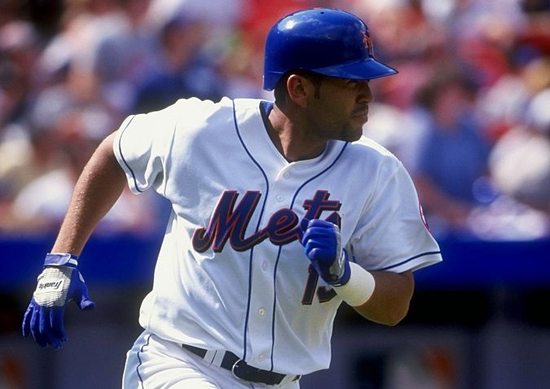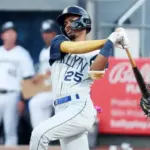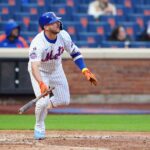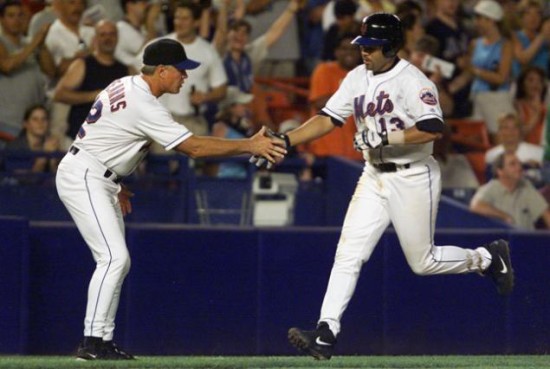
When reviewing second basemen who have worn the orange and blue of the New York Mets, one finds a lack of cohesion and a plethora of change. There were not the stars at second that graced other infield positions and those that did get recognized as Met heroes, often left the team and made their mark elsewhere. Others had consistent careers for the Mets on a long term basis, but failed to have that one standout season necessary to make this list. There were parts of Mets history where the position was like a turnstile lacking a constant presence for an important up-the-middle position in the field.
Since Charlie Neal opened at second in 1962, 27 other players have started on Opening Day for the Mets at second base. A total of 156 players have played at least one game at second in Mets history, including some surprises such as Richie Ashburn who started twice and Larry Bowa, who left his perch at shortstop to play second four times for New York. Only two players, Felix Millan and Wally Backman, opened the season at second five times, with two others starting the season there on four occasions. Not surprisingly, Backman has played the most games at second for the Mets franchise starting 680 times, while Millan was close behind at 674.
Ron Hunt was a staple at second for the Mets in the early sixties, but the turnstiles were busy thereafter and there was not consistency at the position until Ken Boswell took over in 1969. Boswell, along with Millan, anchored the position for most of the seventies until Doug Flynn, who came to the Mets as part of the infamous “Midnight Massacre” on June 15, 1977, took over in late seventies.
The eighties were dominated by Backman and his platoon-mate Tim Teufel. A decade later, Gregg Jefferies burst onto the scene and played into the early nineties, with Jeff Kent taking over as the decade reached its mid-point. Carlos Baerga was most commonly seen at second as the nineties came to an end.
As the new millennium dawned, Edgardo Alfonso, who was originally a third baseman, came onto the scene and started three seasons (1999-2001). After Alfonso left for the San Francisco Giants, Roberto Alomar took over in 2002 and played two seasons at second for New York. Luis Castillo took over at in 2006 and played on and off for four seasons. Daniel Murphy followed for four seasons, from 2012-2015. (Murphy played some second in 2011 but Justin Turner, with 79 starts, played the most). Neil Walker started on Opening Day in 2016 and 2017 while Asdrubal Cabrera manned the bag to start things in 2018. Robinson Cano played 90 games at second in 2019.
There were many more players who played second base for the Mets, some had some success while others were in Flushing to grab a cup of coffee. But it is a diverse group, not without some good to excellent players who made memorable contributions to Mets history. Their five best campaigns follow. It is not a list of the five best players as some of the better second basemen the Mets have had only made the honorable mention and some did not make the list at all. Please list your five top seasons in the comments following the article.
5. Ron Hunt — 1964
No doubt a surprise entry to some, Hunt was the first ‘star’ the Mets had in the early sixties. He was the first All-Star in Mets history in 1964, a game that was played in Hunt’s backyard at Shea Stadium. Hunt’s motto in his professional life was “(s)ome people give their bodies to science; I give mine to baseball.” This refers to his propensity to get plunked, as no one got hit by a pitched ball more than Hunt during his playing career. He still ranks near the top in all-time HBP with 243. (The current leader in that category is Craig Biggio with 285).
In 1963, Hunt had a fine rookie season hitting .272 with 10 home runs and 42 RBIs. He finished second to Pete Rose in Rookie of the Year balloting for the NL in ’63. In 1964, Hunt had his career-year, stroking .303 with six homers and 42 RBIs. Taken in context, not bad at all on a team that went 53-109. Injuries hampered Hunt in 1965, but he bounced back with another All-Star year in 1966.
Ron Hunt is certainly not the first person that comes to mind when Mets second basemen are discussed. But his early contribution to the team in his short, but nice, career with the Mets certainly deserves remembrance and his 1964 season in particular deserves recognition.
4. Wally Backman — 1986
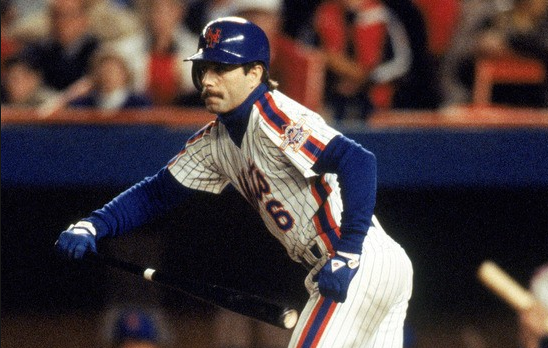
If an analytics department could measure grit, determination and fire, then Wally Backman would head this list easily. As it is, Backman is one of the top second basemen to ever don a Mets uniform. He was the Mets first round pick in 1977 and made it to the big club in September of 1980.
Throughout the first years of his major league career, Backman did not receive steady playing time, playing behind Brian Giles, Bob Bailor among others. A frustrated Backman was sent to the minors in 1983 where he had the fortune of meeting Davey Johnson , the manager of the Triple-A Tidewater Tides. Johnson was promoted to Mets manager in 1984 and named Backman his starter.
Although a switch-hitter, Backman hit much better from the left side of the plate batting .306 across nine seasons with New York. He hit only .164 from the right-side and this caused him to be platooned even during large portions of the Johnson era. In 1986, the Mets acquired right-handed hitting Tim Teufel from the Minnesota Twins and for the next three seasons, Teufel and Backman platooned at second, both proving excellent at setting the table for the big hitters in the lineup.
Backman’s best individual season came in the Mets championship year of 1986. He hit a career-high .320 and had one home run, 27 RBI, 13 stolen bases and a .376 on-base percentage while scoring 67 runs. Backman was better still in the World Series stroking .333/.429/.333 for the Mets. He scored the game-tying run in Game 7 against the Boston Red Sox.
The scrappy, do-it-all Backman won hearts with his grit and determination as a player and later as a manager. His offensive production, by the numbers, does not place him as an all-time great, but if the Mets needed a runner sacrificed to another base, or an important start to a double play, or a bag to be stolen, Backman was the man. His willingness to do whatever it took to win was infectious, and his fiery persona helped the Mets win a championship in ’86 as well as an NLCS appearance in 1988.
3. Daniel Murphy — 2015
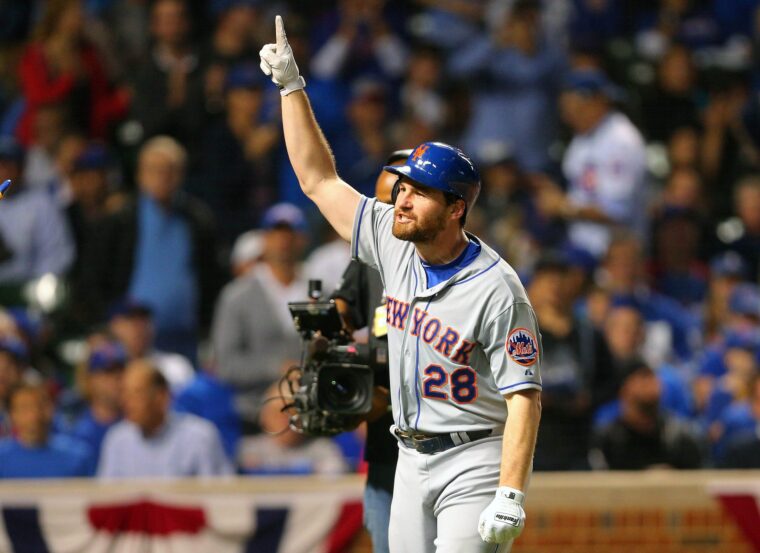
Daniel Murphy lands in the third spot on the list largely due to his hitting ability and an insane, almost unimaginable post-season he had in 2015. A natural third baseman, he was forced to play other positions early in his major league career (left-field, first-base) due to the imposing presence of David Wright at the hot corner.
During parts of seven seasons with the Mets, Murphy amassed 967 hits. He slashed .288/.331/.424 and knocked 228 doubles. Of course, Murphy’s true breakout season didn’t come until he left New York. Still, he did plenty while wearing the Mets uniform and his historic playoff run in 2015 made him a permanent fixture in Mets lore.
After coming off an All-Star season in 2014, Murphy had a solid regular season hitting .281/.322/.449 in 2015. (Throughout his time with the Mets, Murphy hit below .280 only once and that was in his first full season). He had 38 doubles in the ’15 season and finished his Mets career second in doubles hit all-time, with only David Wright besting him. He played first, second and third base that year, but started 77 games at second, the most of any of the three positions he played.
Not known as a power hitter, Murphy struck only 14 homers in 2015 so the offensive explosion that followed in the postseason came as a surprise. Over the course of the NLDS and NLCS, Murphy became the first player in major league history to hit a home run in six consecutive postseason games, beating a record set by Carlos Beltran, and became the second person, after Lou Gehrig, to have a hit, a run and an RBI in seven consecutive postseason games. He also broke a Mets franchise record for most home runs in the postseason, previously held by Mike Piazza. He hit .529 with four home runs, a double and six RBI in the NLCS and was named the series MVP.
And as an addendum, the home runs he hit were off the likes of Jake Arrieta, Zack Greinke and Clayton Kershaw. This trio finished 1-2-3 in Cy Young voting in 2015. Although Murphy cooled down in the World Series against the Kansas City Royals, his postseason exploits were cemented in Mets history.
Muph landed in Washington after the 2015 season where he his power numbers skyrocketed and as all Mets fans know, became a Mets nemesis.
The 2015 regular season was a typical one for Murphy. His post-season was otherwordly. For this, he more than belongs on this list as one of the preeminent infielders the Mets have ever had, owner of one of the most incredible postseasons in MLB history.
2. Edgardo Alfonzo — 1999
A flip of the coin could determine what was the best individual season a Met has had at second base. Both were crafted by Edgardo Alfonzo and in consecutive years. His 1999 season was chosen as second best but could easily rank number one with the 2000 season second.
Before examining the two extraordinary seasons a little bookkeeping first. Some will argue that Alfonzo doesn’t even belong on this list as he split his time almost evenly between third and second base. He appeared in 524 games at second and 515 at third throughout his eight years with New York. Since second base has had a dearth of star talent in Mets history, it seems fitting that Alfonzo should land here.
In his Mets career, Alfonzo stroked 120 home runs hitting to an average of .292 and an .812 OPS. He compiled a 29.6 WAR with New York, more than the next two prolific Mets second basemen combined. He was certainly the most athletic of Mets middle-infielders and his slick fielding landed him on the cover of Sports Illustrated in 1999 as the magazine postulated that Alofonzo, Robin Ventura, Rey Ordonez and John Olerud may have been the best defensive infield ever.
Fonzie was also known as a terrific clutch hitter. His .318 BA with runners in scoring position still stands as a Mets record.
In 1999, Alfonzo shifted to second base when Ventura arrived and went on to have one of his best seasons. He set career-highs with 27 home runs and 108 RBI and won his first and only Silver Slugger Award. He also had 123 runs scored, 191 hits, 41 doubles, a career high 315 total bases, and a .385 on-base percentage. He had many important hits and set a Mets record by going 6-for-6 with three home runs and scoring six runs in a game against the Houston Astros. He finished eighth in MVP voting in 1999.
1. Edgardo Alfonzo — 2000
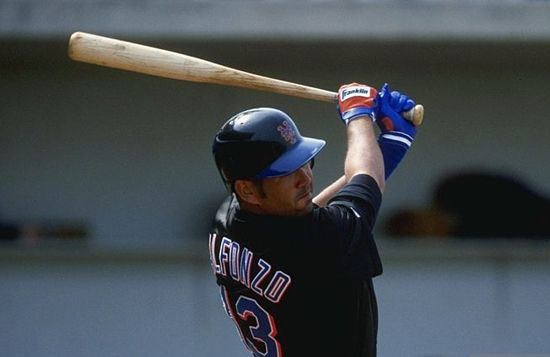
Alfonzo picked up where he left off in 1999 by having another terrific year in 2000. He made his one and only All-Star appearance in 2000 and helped the Mets get to the World Series. Alfonzo set a career-high with a .324 average to go along with 25 home runs and 94 RBI. He also had 109 runs scored, 176 hits, 40 doubles, a remarkable career-high .425 on-base percentage and a career-high .542 slugging percentage.
Alfonso’s clutch hitting continued into the playoffs as he had important hits in Game 1 and Game 3 of the NLDS against the San Francisco Giants. He also stroked .444 in the NLCS against the St. Louis Cardinals. Many pundits believe Alfonzo was just as important as Mike Piazza in the Mets 2000 playoff run.
Injuries hampered Alfonso for a good part of the 2001 season. He returned to form in 2002 once again hitting over .300.
The team announced that Alfonzo would enter the Mets Hall of Fame in 2020, which he called “a dream come true for me.”
“The Mets have had so many great players in their history, and I’m so proud to receive this honor,” Alfonzo said after the induction announcement. “This is something I never thought would be possible when I started out. I was never much for individual goals, I just wanted to help us win.”
Although Alfonzo’s prime years were few, he nevertheless made an indelible mark on the Mets franchise. His 1999 and 2000 seasons rank as the best two a Mets second baseman has ever had in their 59 years of existence and, to many, place him atop the list as the best second baseman the Mets have ever had.
Honorable Mentions
Some notable seasons that Mets second basemen have had that are not listed above:
Felix Millan—1973 season
Tim Teufel—1987 season
Gregg Jefferies—1990 season
Jeff Kent—1993 season


